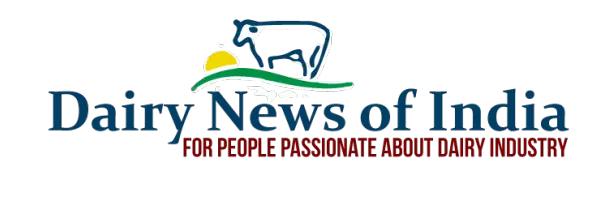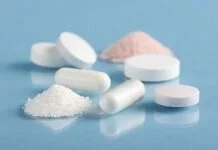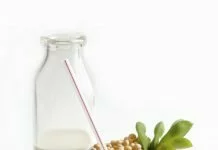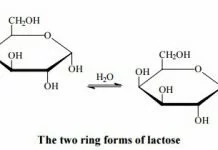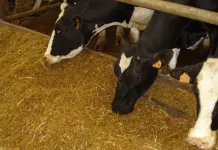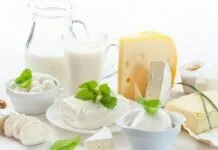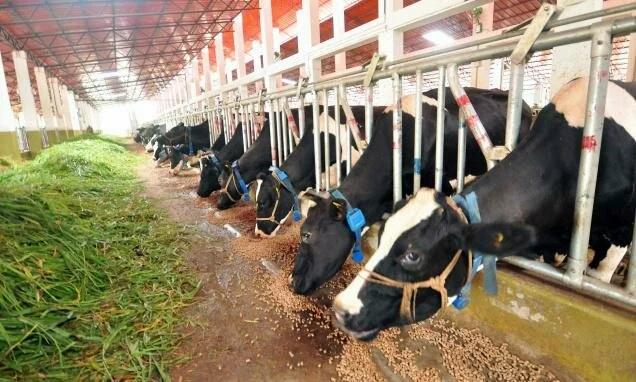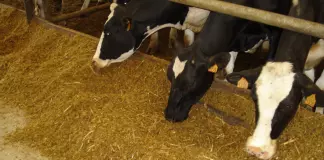Source: fnbnews.com
Cow milk has been used globally for its nutritive and medicinal values in all age groups. There are references on cow milk in ancient Vedas. Ayurveda, the Indian system of medicine, has described in detail the innumerable benefits of cow milk. Charaka (200 B.C.), describes the following properties of cow milk:
“Svadu, sheeta, mridu, snigdha, bahula, shlakshna, pichcchil, guru, manda, and prasanna Dashaguna…” “Cow’s milk has 10 properties: sweet, cold, soft, unctuous, dense, smooth, viscous, heavy, slow and pleasing.” It is said to enhance tissues and immune resistance. Many cow products are used for their health promoting, disease-preventing and therapeutic purposes. Besides its nutritive use, milk and milk products are used in conjunction with medicines to enhance their pharmacokinetic and dynamic benefits. In Ayurvedic rejuvenation programmes, milk is central to tissue regeneration. It contains many beneficial proteins, hormones, growth factors, vitamins and minerals.
Cow milk is constituted of Water – 87%, Carbohydrate (Lactose) – 4.8%, Fat – 4%, Protein (Casein, Whey, Glycoprotein) – 3.4%, Minerals (Ca, K, I) – 0.8%, and Vitamins (A, B2, B12). Casein forms about 80% and whey protein forms about 20% of the total protein content in the milk. Glycoproteins are found in trace fractions. Thus, casein becomes a major source for supply of all essential amino acids (except sulphur-containing amino acids – methionine and cysteine).1 Based on the DNA sequence, casein is classified into four types viz, aS1, aS2, ß, ?. Milk contains lactoferrin that is microbicidal. Mother’s milk helps in establishing healthy microbiome of the gastrointestinal tract.
Debate on ß-casein types in Cow’s Milk
ß-casein is a protein with 209 amino acids chain. At its 67 position, the A1 type is a mutant variant which has the amino acid – Histidine instead of Proline in the natural A2 type. This variant was developed due to mutation in normal A2 beta casein gene about 3,000 years ago in Europe. Indian desi cows did not have this mutation. This mutation leads to an enzymic product of the A1 type in the small intestine. A1 casein, unlike A2 type, is prone to digestion by pepsin, leucine aminopeptidase and elastase. A 7 amino acid peptide, called ß casomorphin 7 (BCM-7) is released by the proteases. BCM-7 binds to the opioid receptors and causes immunosuppression – leading to type 1 diabetes mellitus (DM1), cardiovascular diseases (CVD), autism, metabolic syndrome, schizophrenia2 (Fig. 1).
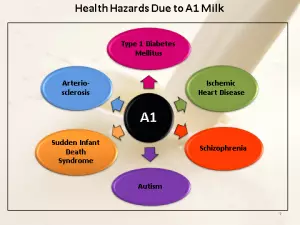
It was in the 1990s that this hypothesis of A1 type of beta casein as a risk factor, was developed by R B Elliot for various diseases. He found that children in Polynesian islands, with an access only to A2 type were at lower risk of Diabetes type 1 than Polynesian children in Auckland who were on A1 type of milk. He further confirmed his hypothesis by in vivo experiments on non-obese diabetic mice. Similarly McLachlan CNS, also in Auckland, found a direct correlation between the mortality rates from coronary heart disease in 16 countries with their national A1 ß-casein consumption (g/day).
Cow Breeds and Types of Milk (A1 or A2)
The type of milk a cow will produce depends on the genotype frequency. Each cow carries two copies of the gene encoding beta-casein with a genotype of A1/A1, A1/A2 or A2/A2. Neither A1 nor A2 trait appears to be dominant. This means that the milk produced by an A1/A2 cow – contain equal proportions of A1 and A2 beta-casein; A1/A1 cows would produce only A1 beta-casein and A2/A2 cows would produce only A2 beta-casein.
The genotype frequencies of different cow breeds are shown in Table 1.
Table 1. Genotype Frequencies of Different Cow Breeds

Indian study by Mishra et al has reported the status of beta casein gene in native Indian cows. From Table 2 it can be seen that, except for Maland Gidda and Kherigarh breeds, all the native cow breeds (Milch as well as non-milch cows) are pure A2 type3. Hence native Indian cows should be pure-bred, chosen, protected and increased in number.
Table 2. Genotype Frequencies of Native Indian Cow Breeds
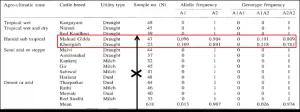
|
